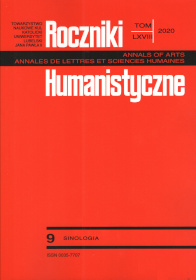Seemingly Inconsistent: “Growing Southern Plants the Michurin Method” by Weronika Murek and Five Spice Street by Can Xue
Abstrakt
Z pozoru niespójne: Hodowla roślin południowych metodą Miczurina Weroniki Murek i Five spice street Can Xue
Porównanie dzieł chińskiej pisarki Can Xue i polskiej pisarki Weroniki Murek pozwala dostrzec istniejące w nich podobieństwa tematyczne i formalne. Pomimo widocznych różnic, pisarki mają wiele wspólnych punktów — w swoich pracach obie zrezygnowały z linii akcji, jedności akcji i miejsca, obie sięgają po surrealizm, absurd, groteskę i paradoks. Prace Can Xue i Weroniki Murek potwierdzają słuszność terminu „literatura światowa”, który jest sublimacją ludzkiego ducha, a jego najgłębsza warstwa jest wspólna dla wszystkich ludzi, niezależnie od ich pochodzenia, kultury i języka.
Bibliografia
Can Xue. Dance of the Dark Soul (Heian linghui de wudao 黑暗灵魂的舞蹈). Wenhui chubanshe 文汇出版社, 2009.
Can Xue 残雪 Shan shang de xiao wu 山上的小屋. Renmin Wenxue 人民文学, 1985, No. 5, pp. 67-69. English edition: Hut on the Mountain. Translated by Ronald Janssen and Jing Zhang. China’s Avant-Garde Fiction: An Anthology, edited by Jing Wang, Duke University Press Books, 1998, pp. 212-216.
Can Xue. Chatka na górze. Translated by Zofia Jakubów. Kamień w lustrze. Antologia literatury chińskiej XX i XXI wieku, edited by Lidia Kasarełło, Państwowy Instytut Wydawniczy, 2019, pp. 465-470.
Can Xue 残雪 Wu xiang jie 五香街. Fuzhou, 2002. English edition: Five Spice Street. Translated by Karen Gernant and Chen Zeping, Yale University Press, 2009.
Damrosch, David. What is World Literature? Princeton University Press, 2003.
Ding, Ling. Pamiętnik panny Sophie. Translated by Irena Kałużyńska. Współczesne opowiadania chińskie, t. 1: Lata 1918-1944, Wydawnictwo Uniwersytetu Warszawskiego, 1995, pp. 87-117.
Duke, Michael S. Modern Chinese Women Writers: Critical Appraisals. Routledge, 1989.
Ebrey, Patricia B. Women and the Family in Chinese History. Taylor & Francis, 2003.
Guisso, Richard W. “Thunder Over the Lake: The Five Classics and the Perception of Woman in Early China.” Historical Reflections/Réflexions Historiques, vol. 8, no.3. women in china: Current Directions in Historical Scholarship, 1981, pp. 47-61.
Hershatter, Gail. Women in China’s Long Twentieth Century. University of California Press, 2007.
Innes, Charlotte. “Foreword.” Old Floating Cloud by Can Xue, translated by Ronald R. Janssen and Jian Zhang, Northwestern University Press, 1991.
Lu, Tonglin. “Can Xue: What Is So Paranoid in Her Writings?” Gender and Sexuality in Twentieth-Century Chinese Literature and Society, edited by Lu Tonglin, State University of New York Press, 1993, pp. 175-204.
Murek, Weronika. Uprawa roślin południowych metodą Miczurina. Wydawnictwo Czarne, 2015.
Nawrot, Jolanta. “Weronika Murek: W rzeczywistości inaczej.” Zamek czyta, www.zamek czyta.pl/ weronika-murek-rzeczywistosci-inaczej/. Accessed 22.12.2019.
Porochista, Khakpour. “The Performance of Fiction: An Interview with Can Xue.” Words without Borders, www.wordswithoutborders.org/dispatches/article/the-performance-of-fiction-an-interview- with-can-xue-porochista-khakpour. Accessed 20.12.2019.
Rong, Cai. The Subject in Crisis in Contemporary Chinese Literature. University of Hawai’i Press, 2004.
Rosenlee, Li-Hsiang Lisa. Confucianism and Women: A Philosophical Interpretation. SUNY Press, 2006.
Saussy, Haun. “‘Wyborny trup’ pozszywany ze świeżych koszmarów. O memach, pszczelich rojach i samolubnych genach.” Niewspółmierność. Perspektywy nowoczesnej komparatystyki. Antologia, edited by Tomasz Bilczewski. Wydawnictwo Uniwersytetu Jagiellońskiego, 2010.
Sowińska, Agnieszka. “Lubię, jak się nie zgadza. Rozmowa z Weroniką Murek.” Dwutygodnik, 02/2015.152, www.dwutygodnik.com/artykul/5727-lubie-jak-sie-nie-zgadza.html. Accessed 20. 12.2019.
“Stubbornly Illuminating ‘the Dirty Snow that Refuses to Melt’: A Conversation with Can Xue.” Interviewed by Laura McCandlish. MCLC Resource Center, 8 Nov. 2014, u.osu.edu/mclc/ online-series/mccandlish/. Accessed 19.12.2019.
Suher, Dylan, and Joan Hua. “An interview with Can Xue.” Asymptote Journal, www.asymptote journal.com/interview/an-interview-with-can-xue/. Accessed 19.12.2019.
Wedell-Wedellsborg, Anne. “Ambiguous Subjectivity: Reading Can Xue.” Modern Chinese Literature, vol. 8, no.1/2, 1994, pp. 7-20.
Who’s who in Contemporary Women’s Writing, edited by Jane Eldridge Miller, Psychology Press, 2001.
Wu, Liang. “Re-membering the Cultural Revolution. Chinese Avant-Garde Literature of the 1980s.” Chinese Literature in the Second Half of a Modern Century: A Critical Survey, edited by Pang-Yuan Chi and David Der-wei Wang, Indiana University Press, 2000, pp. 124-136.
Xie Nandou 谢南斗. “Can Xue yu nuxing wenxue 残雪与女性文学.” Zhongguo wenxue yanjiu 中国文学研究, no. 2, 2002, pp. 27-31.
“Za co nominowaliśmy Weronikę Murek.” Polityka, 2016.01.09, www.polityka.pl/tygodnik polityka/kultura/paszporty/1646674,1,za-co-nominowalismy-weronike-murek.read. Accessed 25.12.2019.
Copyright (c) 2020 Roczniki Humanistyczne

Utwór dostępny jest na licencji Creative Commons Uznanie autorstwa – Użycie niekomercyjne – Bez utworów zależnych 4.0 Międzynarodowe.





